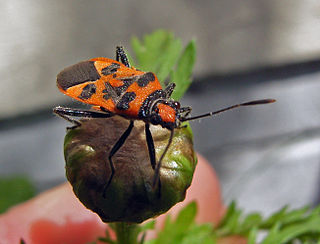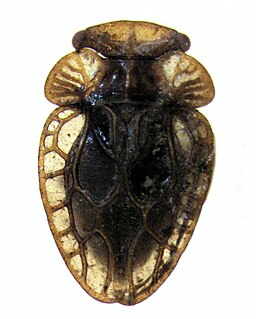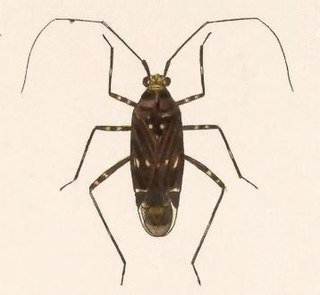
The Pentatomoidea are a superfamily of insects in the Heteroptera suborder of the Hemiptera order. As Hemiptera, they share a common arrangement of sucking mouthparts. The roughly 7000 species under Pentatomoidea are divided into 21 families. Among these are the shield bugs, giant shield bugs, burrower bugs, and stink bugs.

Coreidae is a large family of predominantly sap-suckling insects in the Hemipteran suborder Heteroptera. The name "Coreidae" derives from the genus Coreus, which derives from the Ancient Greek κόρις (kóris) meaning bedbug.

Coreoidea is a superfamily of true bugs in the infraorder Pentatomomorpha which includes leaf-footed bugs and allies. There are more than 3,300 described species in Coreoidea.

The Peloridiidae or moss bugs are a family of true bugs, comprising eighteen genera and thirty-four species. They are small, ranging in length from 2 to 4 mm, rarely seen, peculiarly lumpy, flattened bugs found in Patagonia, New Zealand, eastern Australia, Lord Howe Island, and New Caledonia. All the Peloridiidae species are flightless, except one. Their present distribution suggests they have existed since before the breakup of Gondwana, and their relation to Heteroptera dates back to at least the upper Permian, more than 230 million years ago. Peloridiids are found amongst mosses and liverworts, commonly in association with southern beech forests. They have become known as moss bugs for their habit of feeding on mosses.

The Lygaeidae are a family in the Hemiptera, with more than 110 genera in 4 subfamilies. The family includes the insects commonly known as milkweed bugs, and also some of those known as seed bugs. The family used to be vastly larger, as numerous former subfamilies have been removed and given independent family status, including Artheneidae, Blissidae, Cryptorhamphidae, Cymidae, Geocoridae, Heterogastridae, Ninidae, Oxycarenidae, Pachygronthidae, and Rhyparochromidae, which together constituted well over half of the former family. Many of the species feed on seeds, although some feed on sap (mucivory), and a few, such as the wekiu bug, feed on insects.
Gardena is a genus of thread-legged bugs in the subfamily Emesinae. It is the second-largest genus in the tribe Emesinii. Presently there are 46 described species.

Heterogastridae is a family of lygaeoid bugs consisting of about 20 genera and more than 100 species.

Tessaratomidae is a family of true bugs. It contains about 240 species of large bugs divided into 3 subfamilies and 56 genera.

Schizopteridae is the largest family in the infraorder Dipsocoromorpha and comprises 56 genera and approximately 255 species. Schizopterids are some of the smallest (0.5–2.0 mm) true bugs. Members of this family can be distinguished by their small size, enlarged forecoxae and varying degree of abdominal and genitalic asymmetry in males. Schizopteridae exhibit a wide range of simple and complex wing venation patterns–some species even possess true elytra. The group is currently divided into three subfamilies: Schizopterinae, Ogeriinae and Hypselosomatinae.

Orthops is a genus of plant bugs in the family Miridae. There are at least 30 described species in Orthops.

Cymus is a genus of true bugs in the family Cymidae. There are at least 40 described species in Cymus.

Isometopinae is a subfamily of jumping tree bugs in the family Miridae and are the only members of the Miridae to possess ocelli. The subfamily is split into five tribes. There are 42 genera and approximately 239 described species in Isometopinae.
Sinuessa is a genus of lace bugs in the family Tingidae. There are about eight described species in Sinuessa.
Teleorhinus is a genus of plant bugs in the family Miridae. There are about eight described species in Teleorhinus.

Cacama is a genus of cactus dodgers in the family Cicadidae. There are about 12 described species in Cacama.

Eccritotarsini is a tribe of plant bugs in the family Miridae. There are about 14 genera and at least 40 described species in Eccritotarsini.

Europiella is a genus of plant bugs in the family Miridae. There are more than 30 described species in Europiella.

Cylapus is a genus of plant bugs in the family Miridae. There are about 12 described species in Cylapus.
Colobathristidae is a family of true bugs in the order Hemiptera. There are more than 20 genera and 90 described species in Colobathristidae.

Ischnorhynchinae is a subfamily of seed bugs in the family Lygaeidae. There are about 16 genera and more than 70 described species in Ischnorhynchinae.















